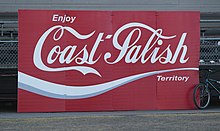
The Kwakwa̱ka̱ʼwakw, also known as the Kwakiutl, are one of the indigenous peoples of the Pacific Northwest Coast. Their current population, according to a 2016 census, is 3,665. Most live in their traditional territory on northern Vancouver Island, nearby smaller islands including the Discovery Islands, and the adjacent British Columbia mainland. Some also live outside their homelands in urban areas such as Victoria and Vancouver. They are politically organized into 13 band governments.

The Vancouver Art Gallery (VAG) is an art museum in Vancouver, British Columbia, Canada. The museum occupies a 15,300-square-metre-building (165,000 sq ft) adjacent to Robson Square in downtown Vancouver, making it the largest art museum in Western Canada by building size. Designed by Francis Rattenbury, the building the museum occupies was originally opened as a provincial courthouse, before it was re-purposed for museum use in the early 1980s. The building was designated the Former Vancouver Law Courts National Historic Site of Canada in 1980.
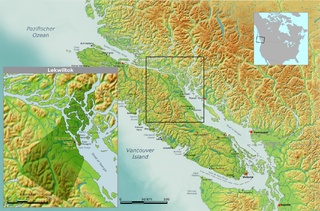
Laich-kwil-tach, is the Anglicization of the Kwak'wala autonomy by the "Southern Kwakiutl" people of Quadra Island and Campbell River in British Columbia, Canada. There are today two main groups : the Wei Wai Kai and Wei Wai Kum just across on the Vancouver Island "mainland" in the town of Campbell River. In addition to these two main groups there are the Kwiakah originally from Phillips Arm and Frederick Arm and the Discovery Islands, the Tlaaluis (Laa'luls) between Bute and Loughborough Inlets—after a great war between the Kwakiutl and the Salish peoples they were so reduced in numbers that they joined the Kwiakah—and the Walitsima / Walitsum Band of Salmon River.
Robert Charles Davidson LL. D. D.F.A., is a Canadian artist of Haida heritage. Davidson's Haida name is G̲uud San Glans, which means "Eagle of the Dawn". He is a leading figure in the renaissance of Haida art and culture. He lives in White Rock, British Columbia.
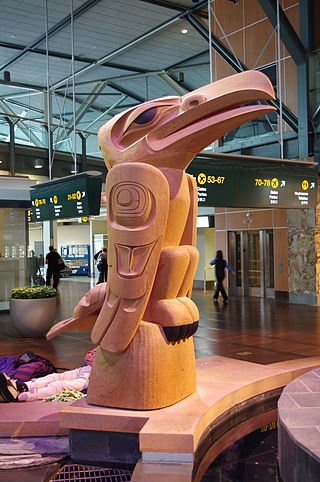
Dempsey Bob, is a Northwest Coast woodcarver and sculptor from British Columbia, Canada, who is of Tahltan and Tlingit First Nations descent. He was born in the Tahltan village of Telegraph Creek on the Stikine River in northwestern B.C., and is of the Wolf clan.
Freda Diesing was a Haida woman of the Sadsugohilanes Clan, one of very few female carvers of Northwest Coast totem poles and a member of the Council of the Haida Nation of British Columbia, Canada. Her Haida name is Skil Kew Wat, meaning "magical little woman."
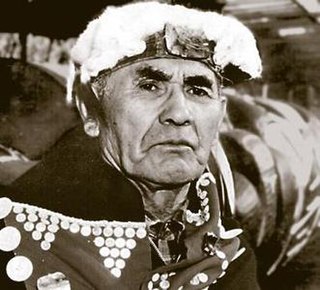
Chief Mungo Martin or Nakapenkem, Datsa, was an important figure in Northwest Coast style art, specifically that of the Kwakwaka'wakw Aboriginal people who live in the area of British Columbia and Vancouver Island. He was a major contributor to Kwakwaka'wakw art, especially in the realm of wood sculpture and painting. He was also known as a singer and songwriter.

Ellen Neel (1916–1966) was a Kwakwakaʼwakw artist woodcarver and is the first woman known to have professionally carved totem poles. She came from Alert Bay, British Columbia, and her work is in public collections throughout the world.

A transformation mask, also known as an opening mask, is a type of mask used by indigenous people of the Northwest Coast and Alaska in ritual dances. These masks usually depict an outer, animal visage, which the performer can open by pulling a string to reveal an inner human face carved in wood to symbolize the wearer moving from the natural world to a supernatural realm. Northwest coast peoples generally use them in potlatches to illustrate myths, while they are used by Alaska natives for shamanic rituals.
"Paul Wong is a Canadian multimedia artist. An artist, curator, and organizer of public interventions since the mid-1970s, Wong is known for his engagement with issues of race, sex, and death. His work varies from conceptual performances to narratives, meshing video, photography, installation, and performance with Chinese-Canadian cultural perspectives".

Michael James Audain, is a Canadian home builder, philanthropist and art collector. He is the Chairman and major shareholder of the privately held Polygon Homes Ltd., one of the largest multi-family builders in British Columbia.

Beau Dick was a Kwakwaka'wakw Northwest Coast artist and Chief who lived and worked in Alert Bay, British Columbia, Canada. He was a contemporary artist, activist and hereditary Chief from the Namgis First Nation. Dick was an artist with an extensive national and international exhibition history.
Lawrence Paul Yuxweluptun is a Cowichan/Syilx First Nations contemporary artist from Canada. His paintings employ elements of Northwest Coast formline design and Surrealism to explore issues as environmentalism, land ownership, and Canada's treatment of First Nations peoples.

Marianne Nicolson is a Dzawada’enuxw visual artist whose work explores the margins at which public access to First Nations artifacts clashes with the preservation of indigenous cultural knowledge. She utilizes painting, photography, mixed-media, sculpture, and installation to create modern depictions of traditional Kwakwaka’wakw beliefs, and has exhibited in Canada and throughout the world since 1992.
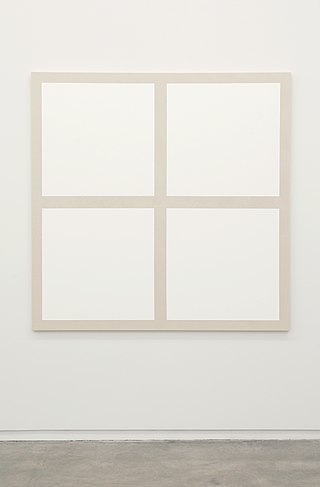
Arabella Campbell is a Canadian artist based in Vancouver, British Columbia. She graduated with a Bachelor of Arts from the University of British Columbia in 1996, and a Bachelor of Fine Arts from Emily Carr University of Art and Design in 2002. She attended the San Francisco Art Institute from 1998 to 2000. She has exhibited locally, nationally, and internationally. She works out of a warehouse studio in False Creek Flats, Vancouver.
The Audain Prize for the Visual Arts is an annual award that recognizes a distinguished Canadian artist. Worth $100,000, it is one of Canada's most significant honours for the arts. The prize is supported by the Audain Foundation and presented by the Audain Art Museum.
Corrine Hunt, also known as Nugwam Gelatleg'lees, is a Kwakwaka'wakw/Tlingit artist, carver, jeweller and designer based in Vancouver, British Columbia, Canada.

Jeneen Frei Njootli is an interdisciplinary Vuntut Gwitchin artist known primarily for their work with sound and textiles, performance, fashion, workshops, and barbeques.
Tarah Hogue is a Canadian curator and writer known for her work with Indigenous art. Hogue is of Métis and settler ancestry and resides in Saskatoon, Saskatchewan. She is the inaugural Curator at Remai Modern.
Joseph Tisiga is a multi-disciplinary artist and a member of the Kaska Dena Nation. He lives and works in Montreal, Quebec.
